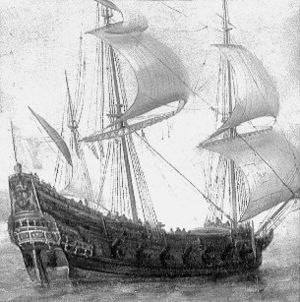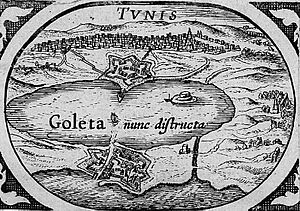Jack Ward facts for kids
Quick facts for kids
John Ward
|
|
|---|---|
| Born | c. 1553 |
| Died | 1622 (aged 68–69) Tunis, Ottoman Tunisia
|
| Nationality | English |
| Piratical career | |
| Nickname | Birdy, Sharky, Yusuf Reïs |
| Type | Barbary Corsair |
| Allegiance | |
| Years active | fl. 1605–1610 |
| Rank | Admiral, Reïs |
| Base of operations | La Goulette, Tunis |
| Commands | Gift, Little John, Reniera e Soderina |
| Wealth | £500,000 - £2,000,000 |
John Ward (born around 1553, died 1622), also known as Birdy or later as Yusuf Reis, was an English pirate. He later became a Barbary Corsair, which means he was a pirate working for the Ottoman Empire. He operated from Tunis in North Africa during the early 1600s.
Some people believe that the famous character Jack Sparrow from the Pirates of the Caribbean movies was inspired by John Ward.
Contents
Biography
Early life and becoming a privateer
John Ward was likely born around 1553 in Faversham, a town in Kent, England. Like many people who grew up near the sea, he worked as a fisherman when he was young.
After England successfully defended itself against the Spanish Armada in 1588, Ward became a privateer. A privateer was like a legal pirate. They had a special license, called a letter of marque, from the Queen of England. This license allowed them to attack and steal from Spanish ships during wartime.
When James I of England became king in 1603, he made peace with Spain. This meant privateers no longer had their licenses. Many of them, including Ward, didn't want to stop their way of life. So, they continued to plunder ships, but now they were considered true pirates because they had no legal permission.
Around 1604, Ward was forced to join a ship working for the King. He served on a ship called the Lyon's Whelp.
Turning to piracy
One day, Ward and about thirty of his shipmates were drinking in a tavern in Plymouth. Ward reportedly said he was tired of working for the King for low pay. He wanted to steal a ship and become a pirate.
Ward and his friends left their ship and stole a small 25-ton boat from Portsmouth Harbour. His shipmates chose him as their captain. This was one of the first times pirates chose their own leader. They sailed to the Isle of Wight and captured another ship called the Violet. They thought it carried treasure, but it was empty. However, Ward used the Violet to capture a much larger French ship.
Ward and his crew then sailed to the Mediterranean Sea. There, he got a Dutch ship with 32 guns, which he renamed The Gift. He first went to Algiers, but some of his men were arrested. So, they sailed to Salé in Morocco. In 1605, more English and Dutch sailors joined Ward's crew.
In the summer of 1606, Ward captured a ship in the Strait of Gibraltar. In August 1606, Ward made a deal with Uthman Dey, the ruler of Tunis. This deal allowed Ward to use Tunis as his base. Uthman Dey was the military leader of Tunis at the time. In return, Uthman Dey would get a share of all the goods Ward captured.
From Tunis, John Ward easily captured many ships from different European countries. His crew captured an English merchant ship called the John Baptist. Ward renamed it Little John. Some of his most valuable captures were two Venetian ships, the Rubi and the Carminati.
The Reniera e Soderina
In early 1607, John Ward prepared his ships Gift, Little John, Rubi, and Carminati for more piracy. His fleet sailed into the Adriatic Sea but was scattered by a big storm. Ward, on Gift, found only the Rubi. They then headed to the Eastern Mediterranean.
On April 26, 1607, near Cyprus and Turkey, Ward saw a huge ship called Reniera e Soderina. It was about 1,400 or 1,500 tons, much larger than his ships. Even though Rubi was 400 tons and Gift was only 200 tons, Ward's crew decided to attack the giant ship.
They fought for three hours. The Reniera e Soderina was too big to move well in the light winds, so its guns couldn't hit Ward's ships. Ward's ships managed to hit the Reniera e Soderina five times, setting fire to hay bales inside. Finally, Ward ordered his ships to get close and prepare to board.
The crew of Reniera e Soderina wanted to fight back. But one of their crew members told the captain to surrender or face a mutiny. The captain agreed, and Ward captured the ship without more fighting. Its cargo was said to be worth a huge amount of money, possibly millions.
The English government thought the cargo was worth about £500,000. Venice, a powerful trading city, was very angry about Ward's piracy. They almost declared war on England because of it.
Conversion to Islam
After returning to Tunis in June 1607, Ward turned the Reniera e Soderina into a powerful warship. His crew added at least 20 new gun ports to fit 60 brass cannons. He planned to sail again in early 1608.
John Ward asked James I of England for a royal pardon, which would forgive his crimes. But the King refused, partly because Venice was threatening war. So, Ward reluctantly went back to Tunis. Uthman Dey, the ruler of Tunis, kept his promise and protected Ward.
Ward decided to convert to Islam, along with his entire crew. He changed his name to Yusuf Reis. He was also called Chakour or Chagour because he used an axe when he was pirating. He married an Italian woman but continued to send money to his English wife. In 1612, a play called A Christian Turn'd Turk was written about his conversion.
Later years
John Ward continued to raid ships in the Mediterranean Sea. He eventually commanded a whole fleet of corsairs, with a Venetian ship with sixty guns as his flagship. After 1612, he stopped being a pirate. Instead, he taught younger corsairs how to use cannons and navigate ships.
He became very rich from his piracy. He retired to Tunis and lived a very comfortable life until he died in 1622. He was about 70 years old and may have died from the plague.
Legacy
From 1609 to 1615, many plays, songs, and books were written about John Ward, calling him "England's Arch-Pirate." Some famous ones include A Christian Turn'd Turk and "Captain Ward and the Rainbow".
It is thought that his nickname was "Sharkey." This nickname is now given to anyone in the Royal Navy with the last name "Ward."
Many TV shows and movies have been based on John Ward's story.
To people at the time, Ward was a mysterious figure. Some saw him like a Robin Hood, who spared English ships but attacked "papist" (Catholic) vessels. John Ward and another pirate named Simon Danseker are known for teaching Barbary corsairs how to use square-rigged ships, which were common in northern Europe.
In recent years, some Turkish newspapers and historians have suggested that John Ward might have been the real-life inspiration for the character Jack Sparrow in the Pirates of the Caribbean movies. The BBC History Magazine also supported this idea.




